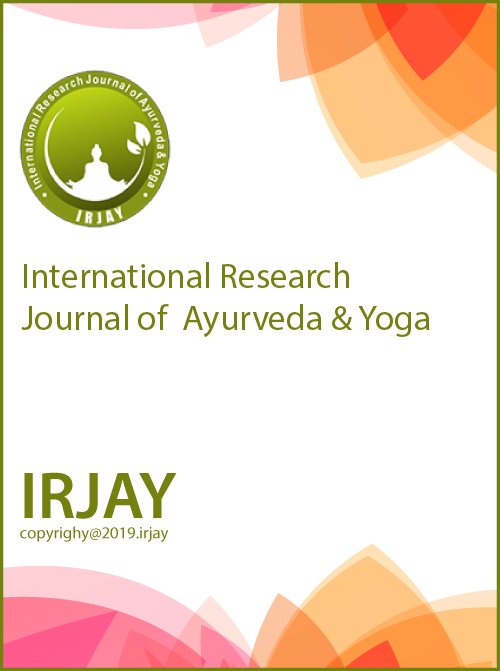A Concept of Viruddha Ahara in Today’s Perspective
DOI:
https://doi.org/10.48165/IRJAY.2023.6106Keywords:
Ayurveda, Health, Diet, Viruddha Ahara, Contradictory diet, incompatibleAbstract
Ayurveda is a science of healthy & peaceful life. Ahara (food) is one of the three Upasthambas (Sub-pillars of the body), which sustain the three main Sthambas (Pillars) of the body. Ahara is very much essential for the sustainment of life of all living beings. According to Ayurveda, it is dangerous to combine certain food items that are incompatible in terms of taste, potencies, time, state of health, place, condition of the doshas, digestive fire, cooking methods, processing quantities, and order of intake rules. According to Ayurvedic text , Viruddha or an incompatible diet refers to meals (diets) and medications that eject the doshas from their regular location but do not remove them from the body. This is known as Viruddha ahara , which causes channel obstruction and results in acute and chronic illnesses. We mindlessly follow the inappropriate food habits in the present age and get skin allergy disorders with unknown etiologies. Consumption of Viruddha Ahara has significantly increased in the modern period. This article discusses the various Viruddha Ahara that are consumed as part of modern living and describes their harmful consequences on health. Ayurveda
Downloads
References
Tripathi B, Charaka. Charaka Samhita (Charak Chandrika Hindi commentary). editors. 1st ed. Sutra Sthana, 11/35Varanasi: Chaukhamba Surbharti Prakashan; 2007.pp.239.
Acharya YT, Agnivesha, Charaka, Dridhabala, Charaka Samhita, Sutra Sthana, 26/81, editor, Reprint. Krishnadas Academy, Varanasi; 2000: p. 149.
Santiago, Sarah E, Grace H Park, and Kelly J Huffman. “Consumption Habits of Pregnant Women and Implications for Developmental Biology: A Survey of Predominantly Hispanic Women in California.” Nutrition Journal 12 (2013): 91. PMC. Web. 22 Oct. 2017.
Garde GK, Sartha Vagbhat- Ashtanghruday Marathi translation, Sutrasthana, chapter 7 sutra 45 8th edition, Raghuvanshi prakashan Pune 2, 1996.pp. 38.
Tripathi B, Charak samhita, charak chandrika- hindi commentary, Sutrasthana, chapter 26, sutra 85 Chaukhamba subharati Prakashan, Varanasi, 2005.pp.496.
Shastri AD, Sushrut samhita, Ayurved tatva sandipika Hindi commentary, Sutrasthana, chapter 20, sutra 20, Publication- Chukhamba Sanskrit Sansthan, Varanasi, 2010.pp. 110
Garde GK, Sartha Vagbhat- Ashtanghruday Marathi translation, Sutrasthana, chapter 7 sutra 45 8th edition,
Raghuvanshi prakashan Pune 2, 1996.pp. 38. 8. Tripathi B, Charak samhita, charak chandrika- hindi commentary, Sutrasthana, chapter 26, sutra 88 Chaukhamba subharati Prakashan, Varanasi, 2005.pp.497 9. Tripathi B, Charak samhita, charak chandrika- hindi commentary, Sutrasthana, chapter 26, sutra 89 Chaukhamba subharati Prakashan, Varanasi, 2005.pp.497. 10. Tripathi B, Charak samhita, charak chandrika- hindi commentary, Sutrasthana, chapter 26, sutra 90 Chaukhamba subharati Prakashan, Varanasi, 2005.pp.497. 11. Tripathi B, Charak samhita, charak chandrika- hindi commentary, Sutrasthana, chapter 26, sutra 90 Chaukhamba subharati Prakashan, Varanasi, 2005.pp.497. 12. Tripathi B, Charak samhita, charak chandrika- hindi commentary, Sutrasthana, chapter 26, sutra 91 Chaukhamba subharati Prakashan, Varanasi, 2005.pp.497. 13. Tripathi B, Charak samhita, charak chandrika- hindi commentary, Sutrasthana, chapter 26, sutra91 Chaukhamba subharati Prakashan, Varanasi, 2005.pp.497. 14. Tripathi B, Charak samhita, charak chandrika- hindi commentary, Sutrasthana, chapter 26, sutra 92 Chaukhamba subharati Prakashan, Varanasi, 2005.pp.497. 15. Tripathi B, Charak samhita, charak chandrika- hindi commentary, Sutrasthana, chapter 26, sutra 93 Chaukhamba subharati Prakashan, Varanasi, 2005.pp.497. 16. Tripathi B, Charak samhita, charak chandrika- hindi commentary, Sutrasthana, chapter 26, sutra 94 Chaukhamba subharati Prakashan, Varanasi, 2005.pp.497. 17. Tripathi B, Charak samhita, charak chandrika- hindi commentary, Sutrasthana, chapter 26, sutra 96 Chaukhamba subharati Prakashan, Varanasi, 2005.pp.497. 18. Tripathi B, Charak samhita, charak chandrika- hindi commentary, Sutrasthana, chapter 26, sutra 97 Chaukhamba subharati Prakashan, Varanasi, 2005.pp.497. 19. Tripathi B, Charak samhita, charak chandrika- hindi commentary, Sutrasthana, chapter 26, sutra 98
Chaukhamba subharati Prakashan, Varanasi, 2005.pp.497. 20. Tripathi B, Charak samhita, charak chandrika- hindi commentary, Sutrasthana, chapter 26, sutra 99 Chaukhamba subharati Prakashan, Varanasi, 2005.pp.497.
Tripathi B, Charak samhita, charak chandrika- hindi commentary, Sutrasthana, chapter 26, sutra 98 Chaukhamba subharati Prakashan, Varanasi, 2005.pp.497.
Tripathi B, Charak samhita, charak chandrika- hindi commentary, Sutrasthana, chapter 26, sutra 99 Chaukhamba subharati Prakashan, Varanasi, 2005.pp.497. 23. Tripathi B, Charak samhita, charak chandrika- hindi commentary, Sutrasthana, chapter 26, sutra 100 Chaukhamba subharati Prakashan, Varanasi, 2005.pp.497. 24. Tripathi B, Charak samhita, charak chandrika- hindi commentary, Sutrasthana, chapter 26, sutra 100 Chaukhamba subharati Prakashan, Varanasi, 2005.pp.497. 25. Tripathi B, Charak samhita, charak chandrika- hindi commentary, Sutrasthana, chapter 26, sutra 101 Chaukhamba subharati Prakashan, Varanasi, 2005.pp.497. 26. Tripathi B, Charak samhita, charak chandrika- hindi commentary, Sutrasthana, chapter 26, sutra 102-103 Chaukhamba subharati Prakashan, Varanasi, 2005.pp. 498, 499.
Shastri AD, Sushrut samhita, Ayurved tatva sandipika Hindi commentary sutrasthana, chapter 20 , sutra 21Chukhamba Sanskrit Sansthan Publication, Varanasi, 2010.pp. 110.

